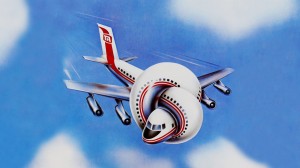What do you call a black man flying an airplane? A pilot, you racist.
It is not complicated, but this meta-joke activates a complex meaning-making process. The setup connotes a genre of racist jokes, inviting the listener to imagine what possible stereotype about black men will fulfill the question in an unexpected way. The answer of “a pilot” is surprising precisely because it is unsurprising. If orthodox racist jokes tend to fulfill psychoanalytic models in their ability to express otherwise forbidden acts of expression, this joke plays more on the surprise theory by inverting dramatic irony to pleasurably expose the listener’s own prejudices and ideally creating some positive self-awareness in the process.
Dramatic irony occurs when the audience knows something a fictional character does not. I read the above joke as an inversion of that particular form because the “audience” for this joke is the one kept in ignorance until the moment of the punchline. Though not necessarily given to social justice for every listener, this joke is ideally didactic in that it makes a pleasurable game of exposing the listener’s prejudices. Neither this form of humor nor its seeming aspirations to a small lesson in social justice are limited to verbal jokes though. To illustrate these points, I turn to an example that uses visual and verbal language to similar ends with relevant contemporary implications.
In 2003, Chappelle’s Show aired a sketch titled “Diversity in First Class.” Although given to left-leaning rhetoric, Chappelle’s Show was not above admissions of prejudice in certain situations. Taking place on a commercial airplane, the camera pans past a pair of men coded as Middle Easterners by their clothing and language. Engaged in a heated discussion, their performance displays aggression in both speech and hand motions. Clearly meant to invoke the image of Islamic terrorists, its original airdate less than 18 months after 9/11 framed its reading in terms of that national trauma. Subtitles further encourage reading the pair as a threat, adding verbal cues to the visual language connoting terrorism. But as the men continue, the subtitles reveal the true nature of their conversation.
By leading his expectations in one direction before dashing them, this contradiction between image and reality makes the viewer foolish. Not only that, but these Others discuss a well-known bit of Western pop culture, making their conversation familiar and laughably non-threatening.
As in the first joke, the viewer’s own prejudices form the basis for misdirection. It is also similarly didactic, though more effectively so. While setup-punchline jokes have a place in culture, it is difficult to imagine a situation in which anyone would ask what you call a black man flying an airplane unless it is in the context of a joke. However, the experience of witnessing someone who might arouse suspicion on an airplane or elsewhere is fairly common. And in many of these situations, we experience a moment of anxiety that quickly passes without reflection in the moment or later when the plane lands without incident.
I don’t want to overstate the power of these sorts of jokes – obviously Chappelle’s Show didn’t cure racism against Arab Americans in the 2000s. But in contradicting words and images, it demonstrates an interesting tactic of humor as rhetoric. Despite the first joke’s explicitness in calling the listener a racist, the effect really comes from the listener laughing at his own racism. In effect these jokes cause the listener to call himself racist, and actually experience a moment of pleasure for his trouble. And in its ability to show instead of tell as well as being situated in a familiar environment, the visual humor of Chappelle’s Show seems that much more effective in its didacticism.
(c) 2013, Phil Scepanski





I would… not disagree, but ‘augment’ only one point in the above. “As in the first joke, the viewer’s own prejudices form the basis for misdirection…” I would say that it is not always the viewer’s own prejudices, but sometimes merely the viewers expectation of a prejudiced outcome that causes the misdirection.
A person can themselves not be prejudiced but familiar enough with common prejudices in society to think they know where a joke is going, but that does not in itself prove that the person has the same prejudice.
Just wanted to point that out. Sometimes people really aren’t racist, but we all live in the same flawed society.
Agreed. I think both jokes posit an ideal (possibly “fictional”) listener/viewer. The actual listener/viewer may or may not align exactly with that ideal, but even in the case where the actual listener would not have appreciated or enjoyed the non-existent racism, decoding the joke forces a type of work that I think has similar effects. I think what you point to is perhaps a difference in whether the actual listener/viewer’s position is disabused or reinforced by the fictional listener/viewer’s position being disabused.
[…] Feature image credit: https://humorinamerica.wordpress.com/2013/02/11/meta-racist-airplane-jokes-the-foolish-audience-and-d… […]
[…] Meta-Racist Airplane Jokes: The Foolish Audience and Didactic Humor by Philip Scepanski […]
My only problem with some of these explanations is what passes for “racism” today. If someone asks what you call a black man flying a plane and I know it a joke, the fact that “pilot” doesn’t come to my mind isn’t necessarily MY racism but the racism I expect in the punchline because I’m expecting something different. If I met someone and they asked me that question I would immediately dislike them until hearing the punchline so the fact that I don’t say “pilot” isn’t my racism. Show me a picture of a black man in a pilots uniform and ask me what that is and I’ll say “pilot”. If I said something hateful like “imposter” them there is a case for racism.